Wealth and Assets in Scotland 2006 - 2012
This report presents analysis of Scottish data from the Wealth and Assets Survey 2006-2012, with a particular focus on findings from the third wave of the survey, covering the period 2010/12. This updates the report Wealth and Assets in Scotland 2006-10, which was published in May 2014.
5. The least wealthy households in Scotland
This chapter looks at the least wealthy 30 per cent of households, referred to here as 'the least wealthy households'[3]. It analyses the socio-demographic characteristics of these households and presents information about the financial assets and non-mortgage borrowing of this group, comparing this to the population as a whole.
Key points
- Households in the least wealthy 30 per cent of households have very few assets, owning just 2 per cent of total wealth in Scotland.
- Single adult and lone parent households were overrepresented in the least wealthy households, making up 46 per cent and 11 per cent of the bottom three deciles, but only 31 per cent and 5 per cent of the population overall.
- Younger households were more likely to be in the least wealthy households. Forty-four per cent of households headed up by someone under 45 were in this group, compared to 21 per cent of those headed up by someone aged 45-64. This reflects the fact that wealth tends to be accumulated through life, with younger households yet to accumulate wealth.
- The least wealthy households were more likely to have an economically inactive head not seeking employment (22 per cent compared to 9 per cent in the population overall) and slightly more likely to be unemployed (5 per cent compared to 2 per cent).
- However, almost half of households in the least wealthy group were headed by somebody in work, which suggests employment on its own is no guarantee that a household will be able to build up wealth.
- Households in the least wealthy households were more likely have a head of household with no qualifications (44 per cent) and to be employed in routine and manual occupations (65 per cent) than the population as a whole (30 per cent and 42 per cent).
- A very large majority (84 per cent) of people in the least wealthy group rented their main residence. Only 11 per cent owned their home, compared to 65 per cent in the population as a whole.
5.1 The share of wealth of the least wealthy 30 per cent
The least wealthy households had very few assets across the three waves of the survey. This is true across all types of wealth. In 2010/12, these households owned:
- 2 per cent of total wealth
- No financial wealth (0 per cent)
- 6 per cent of property wealth
- 7 per cent of physical wealth
- No private pension wealth (0 per cent)
5.2 The demographic composition of the least wealthy households
This section provides information on household type, age, employment status, education, socio-economic group and tenure of the least wealthy 30 per cent of households in Scotland.
5.2.1 Household type
Chart 5.1 shows the household type of the least wealthy households compared with the population as a whole.
Chart 5.1: Household composition, least wealthy 30 per cent and whole population, 2010/12
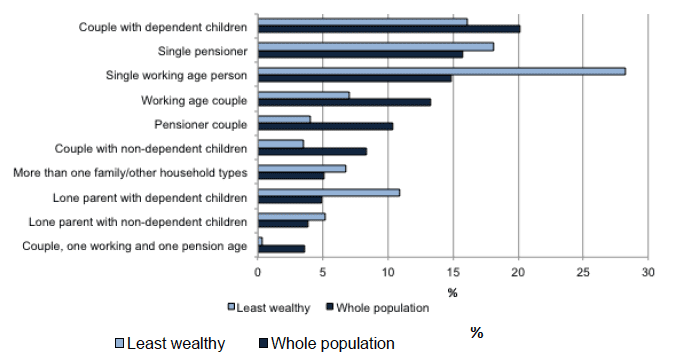
Source: Wealth and Assets Survey, ONS
Single adult households were overrepresented in the least wealthy group. Just under half of the least wealthy households were of this type (28 per cent single adults, 18 per cent single pensioners), compared to less than one in three (15 per cent single adults, 16 per cent single pensioners) in the population as a whole.
Lone parents with dependent children were also overrepresented: 11 per cent of the least wealthy households were lone parent households, compared to just 5 per cent in the population overall.
Chart 5.2 shows the percentage of each household type that is in the least wealthy three deciles.
Chart 5.2: Risk of low wealth by household type, 2010/12
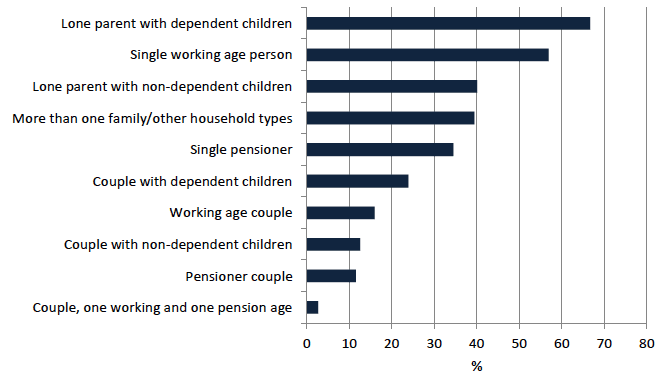
Source: Wealth and Assets Survey, ONS
Lone parents were the most likely to be in the least wealthy households. Two thirds (67 per cent) of all lone parents households in Scotland were in this group. Employment status may provide one explanation for this finding. Current benefit eligibility means this group are not required to seek employment until their youngest child is 5 years old. Additionally, while just under 60 per cent of lone parents were in employment in Scotland, evidence shows that their employment tends to be part time, lower paid, and less secure to fit around caring responsibilities.
Single working age adult households were also very likely to own little wealth, with 57 per cent of all households of this type in the three least wealthy deciles.
By contrast, couple households and couples with adult children were the least likely to be in the least wealthy group. Only 16 per cent of working age couples, 13 per cent of couples with non-dependent children, 12 per cent of pensioner couples and 3 per cent of couples where one half of the couple was a pensioner were in the bottom three wealth deciles.
5.2.2 Age
Chart 5.3 shows the age groups of heads of households of the least wealthy households and the population as a whole.
Households headed up by an adult under 45 were overrepresented in the least wealthy group. Forty-four per cent of households headed by someone under 45 were in the least wealthy group, compared to 21 per cent of those headed up by an adult aged 45-64.
Looking at particular age groups, households headed up by a person aged 25-34 made up 24 per cent of the least wealthy households but only 15 per cent of households overall.
Chart 5.3: Age of head of household, least wealthy 30 per cent and whole population, 2010/12
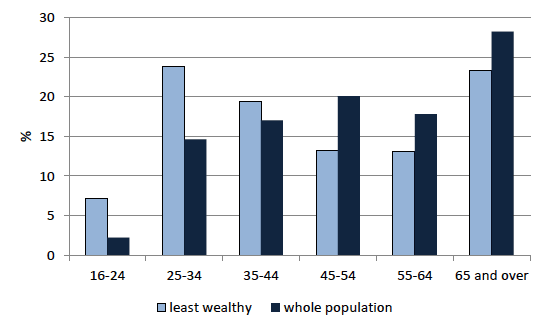
Source: Wealth and Assets Survey, ONS
The relationship between young age and low wealth can be explained by two factors. First, younger individuals tend to have lower earnings, as they are more likely to be in entry level jobs, and thus have less disposable income to save or invest. Second, regardless of income, younger people have simply had less time to accumulate wealth.
5.2.3 Employment status
Chart 5.4 shows the employment status of the head of household in the least wealthy households, compared with the population as a whole.
Almost half the households (47 per cent) in the least wealthy group were headed up by someone employed or self-employed. This suggests that employment is not enough to protect against low wealth.
Heads of households in the least wealthy group were slightly more likely to be unemployed than across the population as a whole (5 per cent compared to 2 per cent) and substantially more likely to be economically inactive (22 per cent compared to 9 per cent).[4]
Chart 5.4 Employment status of head of household, least wealthy 30 per cent and whole population, 2010/12
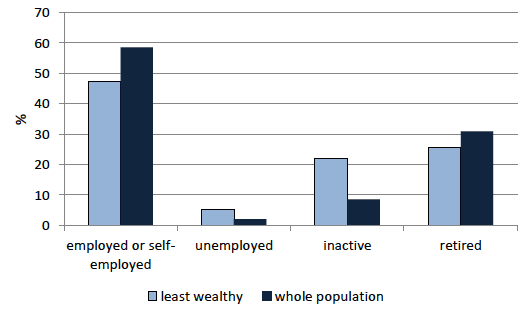
Source: Wealth and Assets Survey, ONS
There are differing reasons why a household may not be seeking employment, however many in this group face barriers to the labour market. The lack of participation in the labour market limits the household capacity to increase income and so accumulate wealth.
5.2.4 Education
Chart 5.5 shows heads of households' highest educational qualification for the least wealthy group and compares it with that for the population as a whole.
Heads of households in the least wealthy households were more likely to have no qualifications (44 per cent) and less likely to be educated to degree level (13 per cent) than the population as a whole (30 per cent and 23 per cent respectively).
Chart 5.5: Education of head of household, least wealthy 30 per cent and whole population, 2010/12
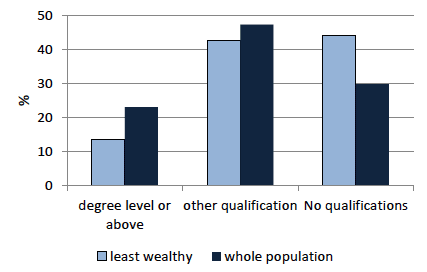
Source: Wealth and Assets Survey, ONS
Education is a driver of both employment status and higher earnings. A lack of qualifications increases the likelihood of unemployment, with higher qualifications leading to many higher level and better paid jobs. A lack of qualifications is also linked with temporary and low paid employment, meaning households may struggle to accumulate wealth.
5.2.5 Socio-economic group
Chart 5.6 shows the socio-economic group of the head of household in the least wealthy thirty per cent of households, and contrasts this with the population as a whole.
Chart 5.6: Socio-economic group of head of household, least wealthy 30 per cent and whole population, 2010/12
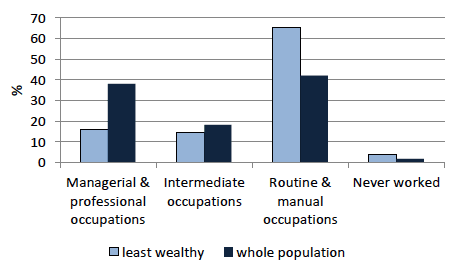
Source: Wealth and Assets Survey, ONS
Almost two thirds of households in the least wealthy group were headed up by someone in a routine or manual occupation, compared to 42 per cent in the population overall. Such occupations are generally low paid, making it difficult for these households to set aside money to accumulate wealth.
By contrast, only 16 per cent of the least wealthy group are were employed in managerial occupations, which tend to be relatively highly paid, compared to 38 per cent of the population as a whole.
Tenure
Chart 5.7 shows the tenure of main residence in the least wealthy 30 per cent of households and the population as a whole.
Chart 5.7 Tenure or main residence, least wealthy 30 per cent and whole population, 2010/12
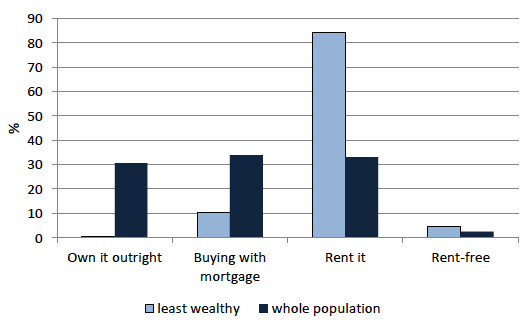
Source: Wealth and Assets Survey, ONS
The very large majority of people in the least wealthy group (84 per cent) rented their home. Only 11 per cent were owner-occupiers, and virtually no one in this group owned their home outright.
In contrast, 65 per cent of the population as a whole were owner occupiers. Almost half of those (31 per cent overall) owned their home outright.
The next section considers in detail the financial assets of the least wealthy households.
5.3 Financial assets of the least wealthy households
Key points:
- Ownership rates of financial assets were lower among the least wealthy 30 per cent of households than the population as a whole. While 79 per cent had a current account in credit, only 24 per cent had a savings account, compared to 47 per cent in the whole population.
- The value of financial assets was also substantially lower among the least wealthy. The median value of all financial assets of people in the least wealthy group was just £500, less than a tenth of the median value for the population as a whole at £5100.
- The percentage of the least wealthy group who had current accounts in credit increased from 69 per cent in 2006/08 to 79 per cent in 2010/12. However, there was no consistent change in this group's ownership rates of other financial assets.
5.3.1 Ownership of financial assets
Chart 5.8 shows the proportion of the least wealthy households with a current account in credit, a savings account in credit, an ISA account, and other financial assets. These are contrasted with the proportions for the whole population.
While 79 per cent of people in the least wealthy group had a current account in credit, this was lower than that for the population as a whole, at 90 per cent.
However, rates of ownership of other financial assets were substantially lower among the least wealthy group than in the population as a whole: 24 per cent of the least wealthy households had money in a savings account, compared to 47 per cent overall; and 15 per cent had an ISA, compared to 40 per cent overall.
Ownership of other financial assets such as shares, insurance products national savings or bonds was generally low throughout the population at 13 per cent or less. Ownership of these assets was even lower for the least wealthy households, at less than 3 per cent.
Chart 5.8 Percentage of households with formal financial assets, least wealthy 30 per cent and whole population, 2010/12
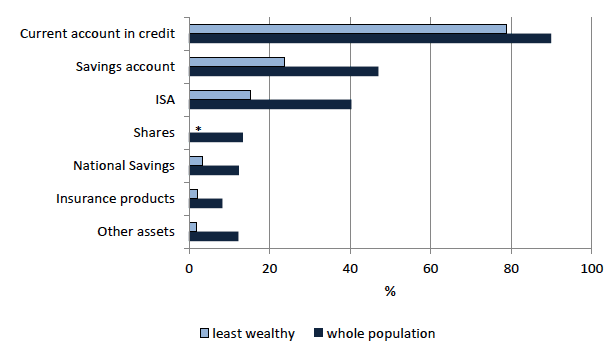
Source: Wealth and Assets Survey, ONS
Notes:
Other assets = Fixed term bonds, Unit investment trusts, bonds or gilts;
Shares = overseas shares, UK shares, employee shares;
Insurance products = Life insurance, Friendly Society or endowment policies (excluding endowments linked to the mortgage). Excluding term insurance policies i.e. life insurance policies which only have a value if you die in the period of the insurance.
* supressed due to N<10
5.3.2 Value of financial assets
Chart 5.9 shows the median value of formal financial assets among those that have them. The median value represents the 'middle point' at which half the people have less and half the people have more.
As discussed above, the majority of the least wealthy households did not have financial assets except for current accounts. The following analysis only includes those households which owned financial assets. In addition, this analysis looks at assets independently of debts. As noted in chapter 2, a large proportion of the least wealthy in terms of financial wealth have negative financial wealth, i.e. more debts than assets.
The median value of all financial assets of households in the least wealthy group was just £500, less than a tenth of the median value for the population as a whole at £5100.
Chart 5.9: Median value of formal financial assets, least wealthy 30 per cent and whole population, 2010/2012
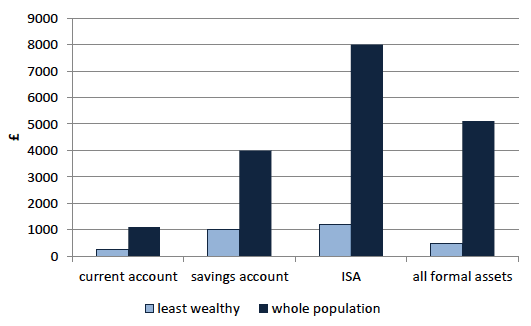
Source: Wealth and Assets Survey, ONS
The median value of current accounts in credit was £300 among the least wealthy households compared with £1100 for the population as a whole.
The gap was larger for savings. Households in the least wealthy group who had savings had on average £1000 in savings accounts compared to £4000 among the population as a whole, and £1200 in ISAs, compared to £8000.
5.3.3 Change in ownership of financial assets over time
Chart 5.10 shows the percentage of households in the least wealthy group holding financial assets over time.
The percentage of households with a current account in credit increased from 69 per cent in 2006/08 to 79 per cent in 2010/12. Change was less consistent for savings accounts and ISAs, with the percentage of holding these assets increasing in 2008/10 but then falling again in 2010/12.
The pattern of change was very similar among the population as a whole, meaning that the relative position of the least wealthy group remained unchanged over time.
Chart 5.10: Percentage of households with formal financial assets, least wealthy 30 per cent 2006/08- 2010/12
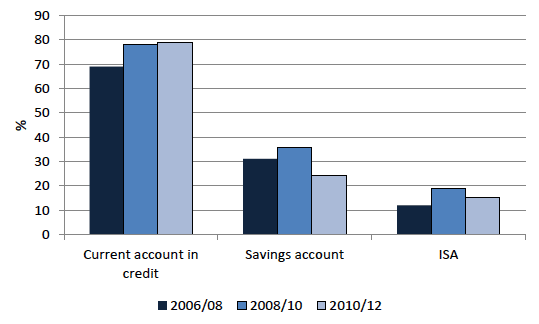
Source: Wealth and Assets Survey, ONS
5.3.4 Change in value of financial assets over time
Table 5.1 and Chart 5.11 show change over time in the median value of financial assets.
Chart 5.11: Median value of formal financial assets - least wealthy 30 per cent, 2006/2008 - 2010/2012
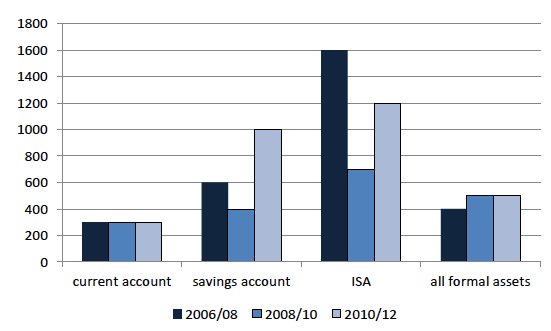
Source: Wealth and Assets Survey, ONS
Table 5:1 Median value of formal financial assets, least wealthy three deciles and whole population, 2006/08 - 2010/12
| Whole population |
Least wealthy |
|||||
|---|---|---|---|---|---|---|
| 2006/08 |
2008/10 |
2010/12 |
2006/08 |
2008/10 |
2010/12 |
|
| Current account |
1,000 |
1,000 |
1,100 |
300 |
300 |
300 |
| Savings account |
3,000 |
2,700 |
4,000 |
600 |
400 |
1,000 |
| ISA |
7,000 |
6,500 |
8,000 |
1,600 |
700 |
1,200 |
| All formal assets |
5,200 |
6,500 |
5,100 |
400 |
500 |
500 |
Source: Wealth and Assets Survey, ONS
Note: Values are absolute values at the time of the survey, i.e. they are not adjusted for inflation
The median value of all formal assets among the least wealthy group increased only very slightly from £400 in 2006/08 to £500 in 2010/12.
Among the population as a whole, the overall median value of formal assets increased from £5200 between 2006/08 to £6500 in 2008/10, but by 2010/12 had returned to just below its original level. This suggests that the situation of the least wealthy group has not changed substantially, both in absolute terms and relative to the situation of the whole population.
Looking at specific types of assets among the least wealthy, the value of current accounts stayed broadly the same over the three waves of the survey. The values of savings accounts and ISAs among the least wealthy group dropped between 2006/08 and 2008/10, but then increased in 2010/12.
This may suggest that the least wealthy were rebuilding their savings slightly after running them down at the onset of the recession. However, it should be noted that these figures are only for the least wealthy group who have savings. The majority of the least wealthy households had no savings at all.
5.3.5 Informal financial assets
There was little difference between the least wealthy households and the population as a whole in terms of informal assets such as cash savings at home, money given to someone to look after, or informal loans given to others that will be repaid.
Both the percentage of people who have informal assets and their value were relatively low. Seven per cent in the least wealthy households had informal assets, with a median value of £450, compared to 9 per cent in the population as whole, with a median value of £600.
However, it should be noted that given the much lower level of formal assets among the least wealthy, informal assets are relatively more important for this group.
The next section looks at non-mortgage borrowing.
5.4 Non-mortgage borrowing
Key points:
- The percentage of households with some form of non-mortgage borrowing was almost the same among the least wealthy 30 per cent of households and the population as a whole, at 38 per cent and 39 per cent respectively.
- However, the types of borrowing differed. The least wealthy 30 per cent were more likely be overdrawn on their current account and have formal loans, and less likely to have outstanding credit card balances or hire purchase agreements.
- 17 per cent of least wealthy households were in arrears, substantially more than among the population as a whole (6 per cent).
- The median amount borrowed among the least wealthy 30 per cent was £1200, about a third of the amount in the population as a whole (£3500).
- The prevalence of credit card debt increased between 2006/08 and 2010/12 while the prevalence of formal loans decreased among the least wealthy 30 per cent of households.
- The value of borrowing remained about the same between 2006/08 and 2010/12 among the least wealthy 30 per cent, but increased by nearly 60 per cent in the population as a whole.
5.4.1 Prevalence of borrowing
Chart 5.12 shows the percentage of households with non-mortgage borrowing in the least wealthy 30 per cent of households and the population as a whole.
In the least wealthy group, 38 per cent of households had some kind of debt, almost the same percentage as in the population as a whole (39 per cent).
However, the least wealthy were more likely to have different types of debt. They were more likely to be overdrawn on their current account (17 per cent compared to 12 per cent in the population as a whole) and have formal loans (15 per cent compared to 13 per cent for the population as a whole).
In contrast, fewer people in the bottom three deciles had outstanding credit card balances (17 per cent compared to 20 per cent) and hire purchase agreements (11 per cent compared to 16 per cent).
However, households in the least wealthy group were substantially more likely to be in arrears on their debt (17 per cent compared to 6 per cent). Almost all of these arrears were household bill arrears.
Chart 5.12: Percentage of households with non-mortgage borrowing, least wealthy 30 per cent and whole population, 2010/12
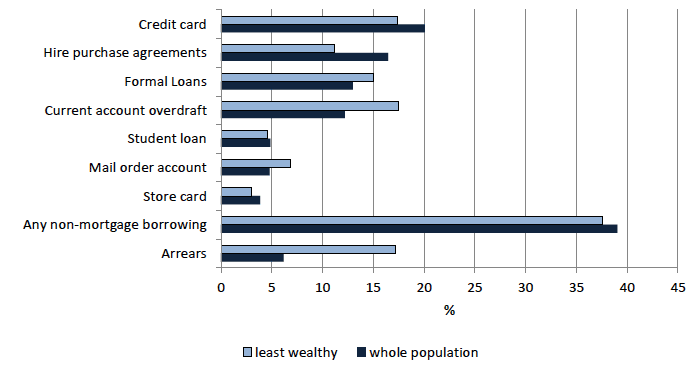
Source: Wealth and Assets Survey, ONS
5.4.2 Value of borrowing
Chart 5.13 shows the median amounts outstanding for household non-mortgage borrowing.
Chart 5.13 Median amounts outstanding for household non-mortgage borrowing, least wealthy 30 per cent and whole population, 2010/2012
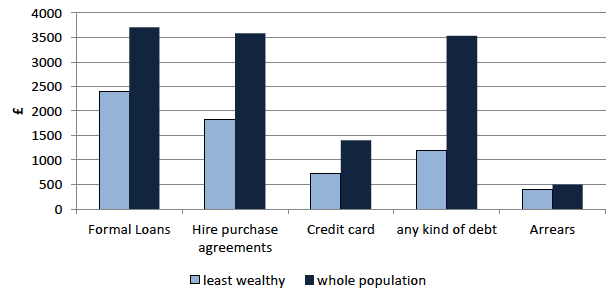
Source: Wealth and Assets Survey, ONS
Households in the least wealthy group had lower median levels of borrowing than the population as a whole, at £1200 compared to £3500. This is likely to reflect their lower ability to make repayments and ability to borrow.
The median level of arrears was slightly lower for the least wealthy group at £400 than the population as a whole at £500, although as noted above, a larger percentage of the least wealthy were in arrears.
5.4.3 Change in the prevalence of borrowing over time
Chart 5.14 shows the percentage of households with non-mortgage borrowing in the least wealthy households over time.
Between 2006/08 and 2010/12 the percentage of the least wealthy households with formal loans fell from 19 per cent to 15 per cent and the percentage with credit card debt increased from 14 per cent to 17 per cent. The percentages with hire purchase agreements and overdrafts increased between 2006/08 and 2008/10, but then fell to their original level by 2010/12.
Chart 5.14: Percentage of households with non-mortgage borrowing, least wealthy 30 per cent. 2006/08 - 2010/12
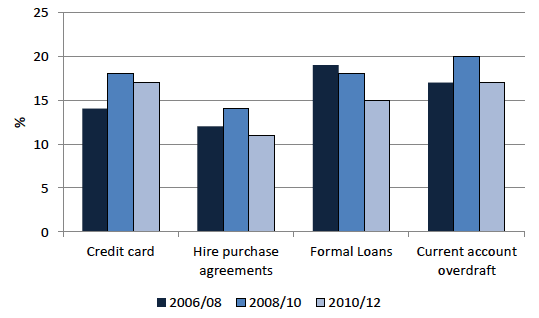
Source: Wealth and Assets Survey, ONS
The pattern of change over time in the population as a whole was similar, but the increase in the percentage with credit card debt and the fall in the percentage with formal loans was more marked. The percentage of households in the population as a whole with credit card debt increased from 10 per cent to 20 per cent, while the percentage with formal loan decreased from 21 to 13 per cent.
5.4.4 Change in amount of borrowing over time
Table 5.2 and Chart 5.15 show change over time in the median value of borrowing.
The overall value of debt held by the least wealthy households increased from £1200 in 2006/08 to £1500 in 2008/10, but by 2010/12 was back down to its original level. Over the same period, the value of borrowing among the population as a whole increased by nearly 60 per cent from £2200 in 2006/08 to £3500 in 2010/12.
Median value of formal loans increased from £1300 in 2006/08 to £2400 in 2010/12 for the least wealthy households. Other types of debt held by the least wealthy households as well as household arrears stayed broadly the same between 2006/08 and 2010/12, with some small change in 2008/10.
Table 5.2: Median amounts outstanding for household non-mortgage borrowing and median household arrears, least wealthy 30 per cent and whole population, 2006/08 - 2010/12
| Whole population |
Least wealthy |
|||||
|---|---|---|---|---|---|---|
| 2006/08 |
2008/10 |
2010/12 |
2006/08 |
2008/10 |
2010/12 |
|
| Formal Loans |
3,200 |
3,700 |
3,700 |
1,300 |
2,500 |
2,400 |
| Hire purchase agreements |
3,000 |
2,900 |
3,600 |
1,800 |
1,000 |
1,800 |
| Credit card |
1,000 |
1,200 |
1,400 |
800 |
1,100 |
700 |
| Any non-mortgage borrowing |
2,200 |
2,300 |
3,500 |
1,200 |
1,500 |
1,200 |
| Arrears |
400 |
600 |
500 |
400 |
600 |
400 |
Source: Wealth and Assets Survey, ONS
Note: Values are absolute values at the time of the survey, i.e. they are not adjusted for inflation
Chart 5.15 Median amounts outstanding for household non-mortgage borrowing and median household arrears - least wealthy 30 per cent, 2006/08 - 2010/12
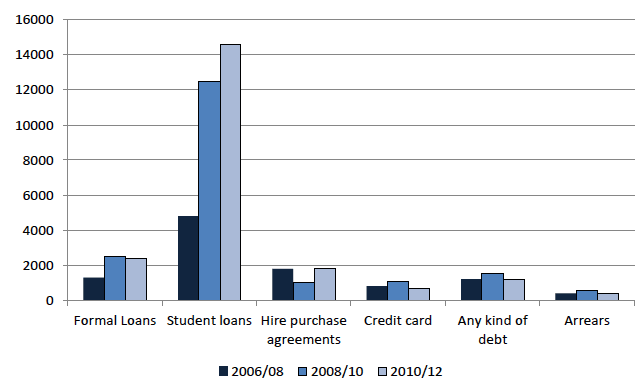
Source: Wealth and Assets Survey, ONS
Note: Values are absolute values at the time of the survey, i.e. they are not adjusted for inflation
The population as a whole also saw an increase in the median value of formal loans and student loans, but of a much smaller magnitude. The median value of formal loans increased from £3200 in 2006/08 to £3700 in 2010/12. The median value of credit card debt in the population as a whole also increased slightly from £1000 to £1400 between 2006/08 and 2010/12.
Contact
Email: Stephen Smith
There is a problem
Thanks for your feedback